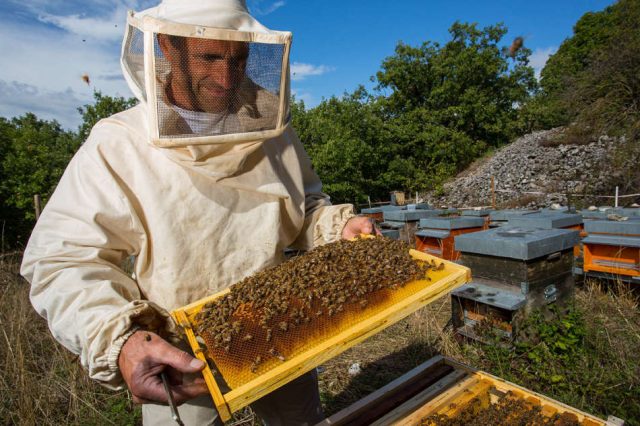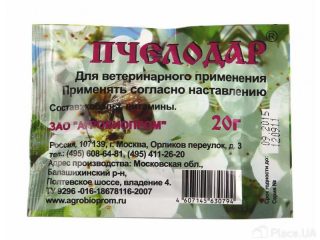Content
Treatment of bees in the fall includes a whole range of measures aimed at creating favorable wintering conditions for bees. The preservation of the bee colony and next year's honey harvest depend on the condition in which the bees spend the winter. This set of measures includes mandatory preventive or therapeutic treatment of hives and bees in order to prevent mass death of insects from diseases and parasites.
Goals of bee treatment in autumn
Losses from bee diseases in the apiary can be significant. Most often, the diseases are mixed. The most common are varroatosis and nosematosis. Dangerous diseases such as ascospherosis, aspergillosis and foulbrood are also detected. This happens most often due to untimely detection of the disease, weakening of colonies, improper feeding, poor bee hygiene and irregular disinfection.
Bees and young individuals, already weakened from summer work, usually go into winter. To protect them from common infections and parasites, the beekeeper must carry out disinfection measures.
Another phenomenon has been discovered that occurs in the fall - a gathering of bee families, when entire families disappear, and the reasons for this are not entirely clear. Beekeepers are inclined to believe that mite attacks are to blame. The bees feel that they cannot overcome the parasites and leave the hives in search of a safe place. Therefore, measures to prevent such tick infestations must be carried out with the beginning of autumn.
Preventing bees from diseases in the fall
After the last honey harvest, bee colonies are usually examined to determine how to prepare the hive for winter. By autumn, bees weaken, they are most susceptible to various diseases and mite infestations. The audit will help you understand what preventive measures need to be taken and what autumn treatment of bees should be carried out.
Even if the inspection does not reveal any problems with the condition of the bees, it is recommended to carry out preventive measures to protect the hive throughout the winter and treat the bees in the fall. One of the important measures is disinfection. It includes:
- Mechanical cleaning.
- Treating frames with disinfectants.
- Removing residual disinfectants.
Good quality food, which needs to be provided to the bee colony in the required quantity throughout the winter, is also a preventive measure against diseases.
Processing times
It is recommended to treat bees in the fall against mites and various infections as early as possible. Treatment should begin after the end of honey collection or immediately after detection of the disease. Otherwise, if the disease actively spreads, the queen may stop producing brood.The greatest effect, as practice shows, is achieved in warm weather, when the daytime temperature outside can still be +100WITH.
How to treat bees in the fall
Recently, a drug such as Bipin has been widely used to prevent diseases. You can also use one of the traditional methods of processing the hive. The dosage of “Bipin” should be established based on the instructions in the instructions and an assessment of the condition of the bee colony. Typically, 10 ml of the prepared solution is used per street.
Treatment with this solution must be carried out at least twice. The first time - immediately after the end of the main bribe, in order to have time to raise healthy brood, and the second time - before the formation of the club.
There are two options for using Bipin:
- spraying the prepared solution using a syringe;
- the use of smoke when burning the drug in smoke cannons.
The first method is considered the most accessible, simple and inexpensive. However, beekeepers highly value the ease of use of the second method. Processing of insects occurs in a matter of minutes. If the apiary is large, then it is advisable to purchase a smoke cannon.
If no signs of disease are found during an autumn inspection, a very simple method can be used to disinfect the hive for preventive purposes:
- The hive is treated with hot air.
- A solution of 100 g of alcohol with 30 g of propolis is applied to the entire surface of the nest.
Bees not only need to be treated, but measures should also be taken to maintain health and strengthen immunity. For this purpose, autumn feeding with industrial preparations “Bee” or “Biospon”, as well as self-prepared “CAS-81” from plant materials, is suitable.
How to treat bees in the fall
Treating bees is a necessary measure aimed at saving the bee colony and increasing honey production. To combat bee diseases in the fall, only approved products should be used in the indicated doses. An overdose is dangerous for eggs, larvae and adults. It can lead to poisoning of individuals and contamination of bee products with drugs.
There are three main treatment methods:
- physical;
- biological;
- chemical.
Physical includes heat treatment of hives and bee colonies. Biological is used using formic and oxalic acids. Chemical involves the use of medications.
What medications to give bees in the fall
One of the most common and effective drugs for treating bee colonies in the fall are products developed on the basis of amitraz, a poison against mites. These include “Bipin”. Experienced beekeepers advise spraying the medicine immediately after the honey bee. Then the greatest result is achieved, and young bees will be less infected with the parasite.
The following remedies also help in treating bees:
- strips of “Bayvarol”, “Aspistan”, which are placed in the nests between the frames for at least 25 days;
- "Timol" - used before the formation of a nest against foulbrood diseases;
- “TEDA” – against varroatosis and acarapidosis, effective up to 99%;
- "Fumagol" - used in the treatment of varroatosis and nosematosis.
Medicines should be given to bees in the fall after preparation and disinfection of nests. It is recommended to use the products for no more than 4 seasons due to the addiction and adaptation of parasites to them.
Use of traditional medicine
Autumn treatment of bees can be carried out with a product made in a traditional way.This is the so-called “CAS-81”, developed by the All-Russian Research Institute of Veterinary Sanitation. You can prepare it yourself according to the following instructions:
- In the spring, prepare pine buds until they swell, along with shoots about 3 cm long.
- Collect wormwood leaves before and during flowering.
- Dry the prepared raw materials separately (the properties are maintained for 2 years).
- Take 50 g of buds, 50 g of wormwood before flowering, 900 g of wormwood during flowering, chop coarsely, add 10 liters of water, boil over low heat for 2 hours.
- Leave the broth for 10 hours, strain through cheesecloth.
It should be used immediately after preparation, adding to sugar syrup for bees at the rate of 50 ml of decoction per 1 liter of syrup. For treatment, you need to feed the bees 5-6 liters of syrup with a medicinal decoction. According to practice, this treatment allows you to get rid of 94% of parasites.
Treating parasites with smoke is considered an effective way to combat ticks. After half an hour of exposure to smoke, dead insects begin to fall to the bottom of the hive. You can use damp fallen leaves as a source of smoke.
The use of oxalic acid is popular among beekeepers to combat mites. The substance is diluted to a certain concentration, poured into a special evaporator and installed above the nest. Evaporating, the product has a detrimental effect on parasites, burning their respiratory tract. Keep it in this position for 3 to 5 days. The outside temperature should be between +140From to +250WITH.
How to treat bees in winter
Hot summers serve as a favorable time for varroa mites to grow and reproduce.Bees, tired from summer work, easily become ill with varroa. And the active spread of this disease occurs in winter.
In order for the family to survive until next summer and begin honey harvest healthy, it is necessary to treat the bees against the parasite for the winter. For this purpose, the medicine “Bipin” was developed. It is also popular among beekeepers because it is inexpensive and easy to use.
It is used in almost all apiaries after the autumn inspection at the end of August before the appearance of offspring, not only for medicinal, but also for preventive purposes. You must act strictly according to the instructions:
- The product in an amount of 0.5 ml should be diluted in 1 liter of warm, clean water.
- Fill a syringe and spray all members of the bee family.
The water should not be hot. The resulting solution takes on a milky color. For processing, you need to purchase an automatic syringe, an IV needle and a measuring cup. One syringe of the product is required per family.
Processing must be carried out outside the hive in special cassettes. After spraying, the mites die and fall off the bees.
Conclusion
Treatment of bees in the fall is one of the most important measures for creating favorable wintering conditions and preserving the bee family. Timely destruction of parasites and prevention of infectious diseases will help bees preserve strength and offspring for fruitful work next summer.











